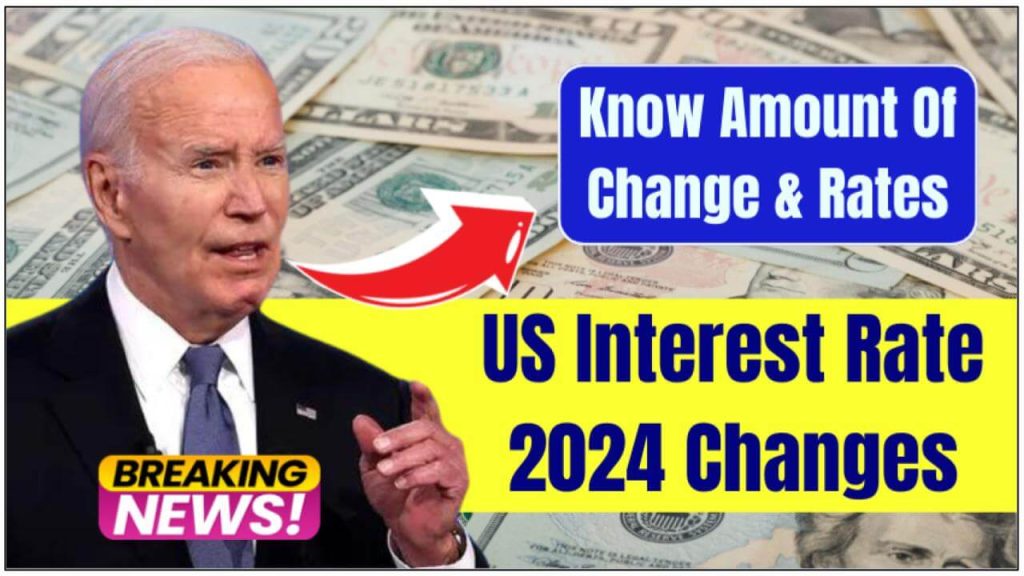US Interest Rate 2024 Changes: In 2024, the U.S. Federal Reserve’s interest rate adjustments have taken center stage, impacting various financial sectors and influencing personal finances for millions of Americans. This year’s rate cuts are designed to stabilize the economy and control inflation amid fluctuating growth and employment data.
For anyone interested in how these changes may affect loans, savings, or investments, this article provides a comprehensive look at the recent adjustments, their motivations, and their economic implications.

In this guide, we’ll cover the Federal Reserve’s rate changes, explain why these changes occur, and provide actionable advice on managing finances amid this shifting economic landscape. Whether you’re a homeowner, investor, or simply curious about economic policy, this guide will help you make informed financial decisions.
US Interest Rate 2024 Changes
| Key Insights | Details |
|---|---|
| Current Interest Rate Range | 4.75% to 5.00% (target range after September 2024 rate cut) |
| 2024 Rate Adjustments | Reduction by 50 basis points in September, with an anticipated 25 basis point cut in November |
| Purpose of Rate Changes | Stabilize inflation, encourage borrowing, and support economic growth |
| Impact on Consumers | Lower borrowing costs for mortgages, car loans, and business investments; may lower savings interest rates |
| Inflation Target | Federal Reserve aims for 2% inflation in the long term |
| Link for Updates | Federal Reserve Official Website |
The Federal Reserve’s interest rate adjustments play a significant role in guiding the U.S. economy, influencing everything from consumer loans to business investments. In 2024, the Fed’s rate cuts have aimed to stimulate economic growth and manage inflation. For consumers and investors, understanding these changes is essential to making informed financial decisions.
By reviewing your finances and adjusting your strategies accordingly, you can effectively navigate the impacts of these rate changes.
Understanding Interest Rates and Their Economic Role
The Federal Reserve’s interest rate, or the federal funds rate, plays a crucial role in shaping the economy. This rate influences how much banks pay to borrow from one another, and in turn, affects the interest rates banks charge consumers. When the Fed changes this rate, it impacts a broad range of financial products, including mortgages, auto loans, personal loans, and credit cards.
Why the Federal Reserve Adjusts Interest Rates
The Fed’s primary goals with US Interest Rate adjustments are to control inflation, foster employment, and support overall economic stability. Here’s a closer look at these objectives:
- Control Inflation: When inflation is high, the Fed may increase interest rates to make borrowing more expensive. This encourages saving over spending, which can help stabilize prices.
- Stimulate Economic Growth: When the economy slows down, the Fed lowers rates to make borrowing cheaper, thus encouraging spending by both businesses and consumers.
- Maintain Employment Levels: Lower rates can help businesses expand, leading to increased hiring and stronger employment rates.
In 2024, the Fed’s decisions have been heavily influenced by the need to stabilize inflation while encouraging economic growth.
Breakdown of Interest Rate Changes in 2024
September 2024 Rate Cut
In September 2024, the Federal Reserve reduced the federal funds rate by 50 basis points (0.5%), adjusting the target range to 4.75% to 5%. This reduction aimed to stimulate economic activity, making borrowing cheaper and, in turn, supporting growth as inflation moved closer to the Fed’s 2% target.
Expected November 2024 Rate Cut
The Fed is expected to announce an additional 25 basis point cut in November, which would lower the target range further to 4.5% to 4.75%. If implemented, this would make it more affordable for consumers and businesses to borrow, ideally spurring spending and economic expansion.
For the latest on this, refer to the Federal Reserve’s official site.
Interest Rate Changes Affect Consumers
US Interest Rate changes directly impact consumers across different areas of personal finance, from mortgages and loans to savings accounts and investments. Let’s dive into the specifics.
Mortgages and Loans
Lower interest rates generally mean lower borrowing costs, which can benefit consumers with mortgages, auto loans, and personal loans. Here’s how:
- Mortgages: Homeowners may be able to refinance at a lower rate, which can lower monthly payments. Those looking to buy can find lower initial interest rates, making home purchases more affordable.
- Car Loans: Buyers may find lower interest rates, reducing their monthly payment amounts and total interest over time.
- Student Loans: Federal rates typically influence private student loans, potentially making education loans more affordable.
However, it’s essential to remember that not all lenders adjust their rates in lockstep with the Fed. It’s wise to shop around for the best rates when considering refinancing or new loans.
Savings and Investments
While lower interest rates benefit borrowers, they can be less favourable for savers. Here’s how it impacts savings accounts, certificates of deposit (CDs), and other investments:
- Savings Accounts: The interest rate on savings accounts has decreased as the Fed’s rate has dropped. For those who rely on interest earnings from savings, this reduction may mean less income.
- Certificates of Deposit (CDs): CDs tend to follow Fed rates, meaning new CDs might offer lower yields.
- Investment Portfolios: Bonds generally become less attractive in a low-interest-rate environment, as they yield less return. Conversely, the stock market often sees a boost, as lower rates encourage borrowing and spending, leading to potentially higher corporate earnings.
What Do Rate Changes Mean for the Economy?
The Federal Reserve’s rate changes are designed to influence the broader economy by either stimulating or cooling down activity. Here’s how these changes manifest in the economy:
- Increased Consumer Spending: When borrowing costs drop, consumers are more likely to take out loans for big purchases, like homes and cars. This boosts economic activity across various sectors.
- Business Investment: Lower borrowing costs make it easier for businesses to invest in equipment, expand operations, and hire more staff.
- Market Confidence: Lower rates often boost stock market confidence, as investors anticipate stronger corporate profits due to decreased financing costs.
Social Security November Payment Update For Pre-1997 Retirees: Check Eligibility and Process
Social Security Payments Halted This Week in November 2024: Check Your Eligibility and Amounts
$8000 SSI Hike For Married SSI Recipients In 2024: Know Eligibility & Application Process
Guide to Manage Your Finances Amid Interest Rate Changes
The effects of changing interest rates can feel complex, but there are practical steps to help you navigate this evolving financial landscape:
Step 1: Review and Optimize Your Loans
Take a close look at your existing loans, particularly any with variable rates that adjust according to the Fed rate. You may benefit from refinancing to a fixed rate, especially if rates are low and expected to rise in the future.
Step 2: Evaluate Your Savings Strategy
Lower rates on traditional savings accounts may mean a lower return on deposits. Consider high-yield savings accounts, which may offer slightly better returns, or explore other low-risk investment options like CDs.
Step 3: Diversify Your Investment Portfolio
In a low-interest-rate environment, bond yields may be less attractive. Diversifying into other asset classes, such as stocks or mutual funds, may help balance your portfolio. Always consult with a financial advisor to create a strategy that aligns with your goals and risk tolerance.
Step 4: Stay Informed on Fed Announcements
Understanding the Fed’s rate decisions can help you make proactive financial choices. Follow economic updates and announcements on the Federal Reserve’s website.
FAQs On US Interest Rate 2024 Changes
Q1: Why does the Federal Reserve change interest rates?
The Fed adjusts rates to control inflation and stimulate economic growth. Higher rates can slow inflation, while lower rates encourage borrowing and spending.
Q2: How often does the Fed change interest rates?
The Fed reviews economic data at eight scheduled meetings each year, though it can adjust rates between meetings if necessary.
Q3: What is the expected trend for interest rates in 2024?
The Fed cut rates in September and is expected to announce another reduction in November. Future changes depend on economic data, especially inflation and employment figures.
Q4: How does a rate cut affect my credit card interest rate?
Credit card interest rates typically follow the prime rate, which is influenced by the Fed’s rate. Lower rates may result in reduced credit card interest rates, though this varies by lender.
Q5: What is the impact of rate changes on inflation?
Lower rates can lead to increased spending, which might raise inflation slightly. However, the Fed’s rate cuts are designed to keep inflation near its 2% target.

